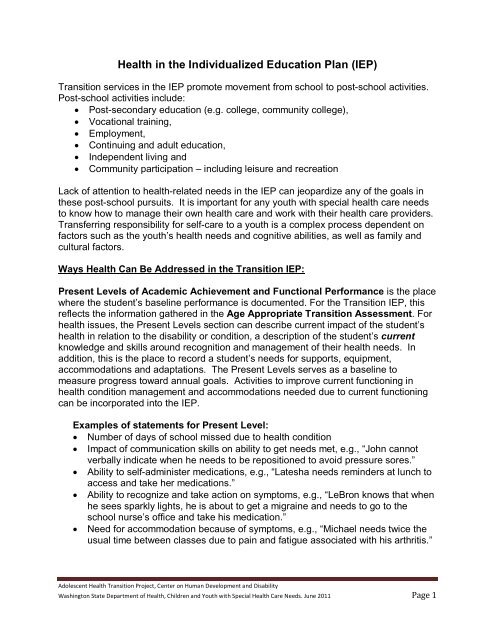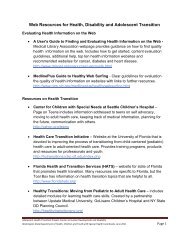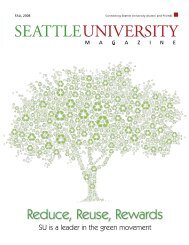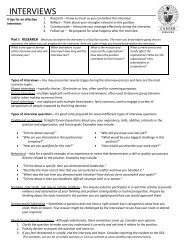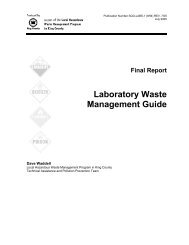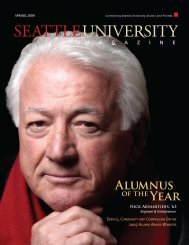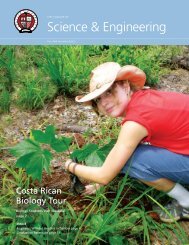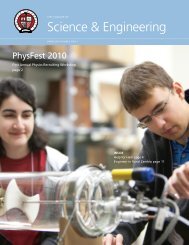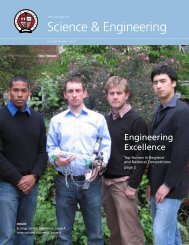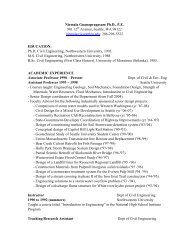Health in the Individualized Education Plan (IEP)
Health in the Individualized Education Plan (IEP)
Health in the Individualized Education Plan (IEP)
Create successful ePaper yourself
Turn your PDF publications into a flip-book with our unique Google optimized e-Paper software.
<strong>Health</strong> <strong>in</strong> <strong>the</strong> <strong>Individualized</strong> <strong>Education</strong> <strong>Plan</strong> (<strong>IEP</strong>)<br />
Transition services <strong>in</strong> <strong>the</strong> <strong>IEP</strong> promote movement from school to post-school activities.<br />
Post-school activities <strong>in</strong>clude:<br />
• Post-secondary education (e.g. college, community college),<br />
• Vocational tra<strong>in</strong><strong>in</strong>g,<br />
• Employment,<br />
• Cont<strong>in</strong>u<strong>in</strong>g and adult education,<br />
• Independent liv<strong>in</strong>g and<br />
• Community participation – <strong>in</strong>clud<strong>in</strong>g leisure and recreation<br />
Lack of attention to health-related needs <strong>in</strong> <strong>the</strong> <strong>IEP</strong> can jeopardize any of <strong>the</strong> goals <strong>in</strong><br />
<strong>the</strong>se post-school pursuits. It is important for any youth with special health care needs<br />
to know how to manage <strong>the</strong>ir own health care and work with <strong>the</strong>ir health care providers.<br />
Transferr<strong>in</strong>g responsibility for self-care to a youth is a complex process dependent on<br />
factors such as <strong>the</strong> youth’s health needs and cognitive abilities, as well as family and<br />
cultural factors.<br />
Ways <strong>Health</strong> Can Be Addressed <strong>in</strong> <strong>the</strong> Transition <strong>IEP</strong>:<br />
Present Levels of Academic Achievement and Functional Performance is <strong>the</strong> place<br />
where <strong>the</strong> student’s basel<strong>in</strong>e performance is documented. For <strong>the</strong> Transition <strong>IEP</strong>, this<br />
reflects <strong>the</strong> <strong>in</strong>formation ga<strong>the</strong>red <strong>in</strong> <strong>the</strong> Age Appropriate Transition Assessment. For<br />
health issues, <strong>the</strong> Present Levels section can describe current impact of <strong>the</strong> student’s<br />
health <strong>in</strong> relation to <strong>the</strong> disability or condition, a description of <strong>the</strong> student’s current<br />
knowledge and skills around recognition and management of <strong>the</strong>ir health needs. In<br />
addition, this is <strong>the</strong> place to record a student’s needs for supports, equipment,<br />
accommodations and adaptations. The Present Levels serves as a basel<strong>in</strong>e to<br />
measure progress toward annual goals. Activities to improve current function<strong>in</strong>g <strong>in</strong><br />
health condition management and accommodations needed due to current function<strong>in</strong>g<br />
can be <strong>in</strong>corporated <strong>in</strong>to <strong>the</strong> <strong>IEP</strong>.<br />
Examples of statements for Present Level:<br />
• Number of days of school missed due to health condition<br />
• Impact of communication skills on ability to get needs met, e.g., “John cannot<br />
verbally <strong>in</strong>dicate when he needs to be repositioned to avoid pressure sores.”<br />
• Ability to self-adm<strong>in</strong>ister medications, e.g., “Latesha needs rem<strong>in</strong>ders at lunch to<br />
access and take her medications.”<br />
• Ability to recognize and take action on symptoms, e.g., “LeBron knows that when<br />
he sees sparkly lights, he is about to get a migra<strong>in</strong>e and needs to go to <strong>the</strong><br />
school nurse’s office and take his medication.”<br />
• Need for accommodation because of symptoms, e.g., “Michael needs twice <strong>the</strong><br />
usual time between classes due to pa<strong>in</strong> and fatigue associated with his arthritis.”<br />
Adolescent <strong>Health</strong> Transition Project, Center on Human Development and Disability<br />
Wash<strong>in</strong>gton State Department of <strong>Health</strong>, Children and Youth with Special <strong>Health</strong> Care Needs. June 2011 Page 1
Measurable Postsecondary Goals must be measurable and must occur after <strong>the</strong><br />
student graduates from school. The goals should always address <strong>the</strong> areas of<br />
education/tra<strong>in</strong><strong>in</strong>g and employment. If appropriate, postsecondary goals should also<br />
address <strong>the</strong> area of <strong>in</strong>dependent liv<strong>in</strong>g. Independent liv<strong>in</strong>g skills are def<strong>in</strong>ed as skills or<br />
tasks that contribute to <strong>the</strong> successful <strong>in</strong>dependent function<strong>in</strong>g of an <strong>in</strong>dividual <strong>in</strong><br />
adulthood <strong>in</strong> <strong>the</strong> doma<strong>in</strong>s of leisure/recreation, home ma<strong>in</strong>tenance, personal care, and<br />
community participation. The <strong>IEP</strong> team decides whe<strong>the</strong>r <strong>the</strong>re is a need for goals <strong>in</strong> <strong>the</strong><br />
area of Independent Liv<strong>in</strong>g. Depend<strong>in</strong>g on <strong>the</strong> student, health issues can be important<br />
<strong>in</strong> each of <strong>the</strong>se areas, but health issues are most often found <strong>in</strong> <strong>the</strong> area of personal<br />
care.<br />
Examples of Postsecondary Goals<br />
• After high school, Anna will live <strong>in</strong> her own apartment and manage her diabetes<br />
<strong>in</strong>dependently.<br />
• After graduation, Joshua will hire and manage his own personal care attendant.<br />
Measurable Annual Goals address not only recommendations for specially designed<br />
<strong>in</strong>struction related to <strong>the</strong> general education curriculum, but also education needs that<br />
result from <strong>the</strong> student’s disability. For transition students, <strong>the</strong>se goals can also address<br />
post school activities of <strong>the</strong> Postsecondary Goals. These goals should <strong>in</strong>clude as much<br />
self-care and <strong>in</strong>dependent management of health conditions as possible so as to<br />
optimize adulthood employment, <strong>in</strong>dependent liv<strong>in</strong>g and community participation.<br />
Examples of Annual Goals<br />
• John will learn self-ca<strong>the</strong>terization so he can <strong>in</strong>dependently take care of his<br />
toilet<strong>in</strong>g needs while attend<strong>in</strong>g cul<strong>in</strong>ary school.<br />
• Monique will contact two adult health care providers to <strong>in</strong>terview dur<strong>in</strong>g <strong>the</strong> first<br />
semester so she can chose a provider who will care for her before she turns 21.<br />
• Yuri will learn to order and pay for his medic<strong>in</strong>es so he can live <strong>in</strong>dependently <strong>in</strong><br />
<strong>the</strong> community<br />
• Keisha will identify symptoms that need urgent and emergent care and will<br />
develop a plan for emergency care.<br />
• James will learn how his oral care habits, medications and diabetes affect his<br />
teeth and oral health and identify a dentist to care for him.<br />
• Jo will understand how alcohol and o<strong>the</strong>r drugs <strong>in</strong>teract with her seizure<br />
medications so she can live safely <strong>in</strong> <strong>the</strong> community.<br />
• Makeala will create a health organizer to track medications and appo<strong>in</strong>tments<br />
with her physicians.<br />
Related Services, Supplementary Aids, Program Modifications - Accord<strong>in</strong>g to <strong>the</strong><br />
IDEA law, each <strong>IEP</strong> should <strong>in</strong>clude a statement of related services, supplementary aids,<br />
program modifications and/or supports needed to help <strong>the</strong> youth progress on <strong>the</strong> annual<br />
goals, be ma<strong>in</strong>streamed when possible, and participate <strong>in</strong> extracurricular and nonacademic<br />
school activities as appropriate.<br />
Adolescent <strong>Health</strong> Transition Project, Center on Human Development and Disability<br />
Wash<strong>in</strong>gton State Department of <strong>Health</strong>, Children and Youth with Special <strong>Health</strong> Care Needs. June 2011 Page 2
Related services can <strong>in</strong>clude school nurse services, school health services,<br />
transportation, <strong>the</strong>rapies such as OT, PT and Speech, psychological services,<br />
counsel<strong>in</strong>g, <strong>the</strong>rapeutic recreation and modified physical education. Some health<br />
related goals will require <strong>the</strong> school nurse and o<strong>the</strong>rs might be carried out by school<br />
personnel with tra<strong>in</strong><strong>in</strong>g and/or monitor<strong>in</strong>g from a registered nurse or <strong>the</strong>rapist.<br />
Examples of Accommodations/Modifications:<br />
• Immediate access to water or <strong>in</strong>clusion of a water bottle throughout <strong>the</strong> day<br />
• Permission to have snacks available because of blood sugar or o<strong>the</strong>r health<br />
problems<br />
• Use of smart phone or alarm watch to track medication schedule<br />
• Shortened school day or class period to accommodate reduced stam<strong>in</strong>a<br />
<strong>Health</strong> Topics That Can Be Addressed <strong>in</strong> <strong>the</strong> <strong>IEP</strong><br />
<strong>Health</strong>y Choices <strong>in</strong> Daily Life – especially those impact<strong>in</strong>g home liv<strong>in</strong>g and<br />
<strong>in</strong>dependence, leisure and recreation, and community life<br />
• Nutrition<br />
o Food choices, <strong>in</strong>clud<strong>in</strong>g limitations or parameters<br />
o Basic cook<strong>in</strong>g skills, <strong>in</strong>clud<strong>in</strong>g safety<br />
o Shopp<strong>in</strong>g<br />
• Cleanl<strong>in</strong>ess and safety <strong>in</strong> home<br />
• Personal hygiene and emotional health<br />
• Physical activity<br />
• Safety at home and <strong>in</strong> <strong>the</strong> community<br />
• Understand<strong>in</strong>g effects of recreational drugs, alcohol on health conditions<br />
• Relationships and sexuality<br />
Manag<strong>in</strong>g <strong>Health</strong> Conditions<br />
• Develop<strong>in</strong>g a personal health history and care plan for health condition(s)<br />
• Understand<strong>in</strong>g and manag<strong>in</strong>g medications<br />
o Pharmacy location and access<br />
• Learn<strong>in</strong>g to self-advocate at <strong>the</strong> doctor’s office – speak<strong>in</strong>g up for needs, ask<strong>in</strong>g<br />
questions<br />
• What to do <strong>in</strong> an emergency<br />
o Know<strong>in</strong>g signs and needs for personal emergency care and how to access<br />
that care<br />
o Know<strong>in</strong>g what to do <strong>in</strong> a disaster such as an earthquake<br />
<strong>Health</strong> and Employment<br />
• Does health or disability condition require work accommodations?<br />
o Physical environment<br />
o Work hours<br />
o Medication adm<strong>in</strong>istration<br />
Adolescent <strong>Health</strong> Transition Project, Center on Human Development and Disability<br />
Wash<strong>in</strong>gton State Department of <strong>Health</strong>, Children and Youth with Special <strong>Health</strong> Care Needs. June 2011 Page 3
o O<strong>the</strong>r accommodations?<br />
• Does health or disability condition require skill development for ma<strong>in</strong>ta<strong>in</strong><strong>in</strong>g<br />
employment?<br />
o Self care activities<br />
o Self advocacy for health needs<br />
Nuts and Bolts of <strong>the</strong> <strong>Health</strong> System<br />
• How to get health <strong>in</strong>surance<br />
• Keep<strong>in</strong>g an accurate, up-to-date medical history<br />
• Choos<strong>in</strong>g and connect<strong>in</strong>g with an adult physician<br />
• Arrang<strong>in</strong>g transportation to appo<strong>in</strong>tments<br />
Adolescent <strong>Health</strong> Transition Project, Center on Human Development and Disability<br />
Wash<strong>in</strong>gton State Department of <strong>Health</strong>, Children and Youth with Special <strong>Health</strong> Care Needs. June 2011 Page 4


